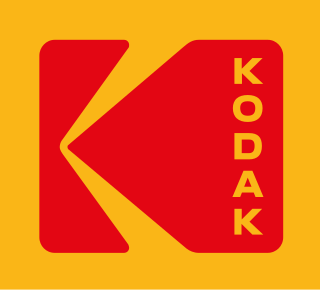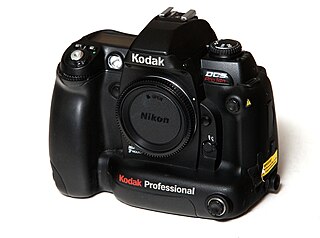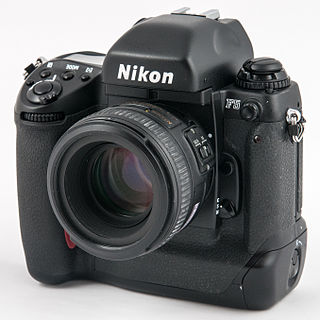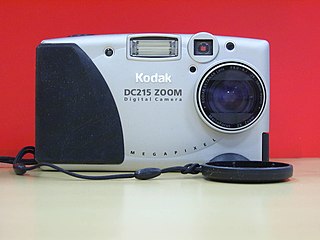
The Eastman Kodak Company, referred to simply as Kodak, is an American public company that produces various products related to its historic basis in film photography. The company is headquartered in Rochester, New York, and is incorporated in New Jersey. It is best known for photographic film products, which it brought to a mass market for the first time.

In photography, reversal film or slide film is a type of photographic film that produces a positive image on a transparent base. Instead of negatives and prints, reversal film is processed to produce transparencies or diapositives. Reversal film is produced in various sizes, from 35 mm to roll film to 8×10 inch sheet film.
The Kodak Professional DCS Pro SLR/n is a 13.5 megapixel full-frame 35mm digital SLR produced as a collaboration between Nikon Corporation and Eastman Kodak. It was an improved version of the Kodak Professional DCS Pro 14n series, and was based on a modified Nikon N80 film SLR and thus compatible with almost all Nikon F mount lenses. The camera was announced in early 2004 and became available to purchase mid-year. A monochrome variant named Kodak Professional DCS Pro SLR/n m of the camera existed as well.
The Cineon System was one of the first computer based digital film systems, created by Kodak in the early 1990s. It was an integrated suite of components consisting a motion picture film scanner, a film recorder and workstation hardware with software for compositing, visual effects, image restoration and color management.

The Kodak Professional DCS Pro SLR/c is a 13.5 megapixel digital SLR camera produced by Eastman Kodak. It is full frame—it uses an image sensor that is the full size of a 35 mm frame. It is compatible with Canon EOS lenses. The camera was launched on March 18, 2004, and incorporates the internal systems of the previous Nikon-compatible SLR/n in a Sigma SA9 SLR body.

Kodak EasyShare was a sub-brand of Eastman Kodak Company products identifying a consumer photography system of digital cameras, snapshot thermal printers, snapshot thermal printer docks, all-in-one inkjet printers, accessories, camera docks, software, and online print services. The brand was introduced in 2001, and discontinued in 2012, when Kodak stopped manufacturing and selling all digital cameras and photo frames.

The Kodak Professional DCS Pro 14n is a professional Nikon F80 based F-mount digital SLR produced by Eastman Kodak. It was announced at the photographic trade show photokina in Germany during September 2002; production examples became available in May 2003.

The Kodak DCS 300 series comprises two cameras, the DCS 315 and DCS 330. They are professional-level digital SLR cameras built by Eastman Kodak's Kodak Professional Imaging Solutions division. They were based on the Nikon Pronea 6i APS SLR camera and were aimed at a lower price point than other models in the Kodak DCS range. The 1.5 megapixel DCS 315 was launched in 1998, while the 3 megapixel DCS 330 was launched in 1999.

The Kodak Professional Digital Camera System or DCS, later unofficially named DCS 100, was the first commercially available digital single-lens reflex (DSLR) camera. It was a customized camera back bearing the digital image sensor, mounted on a Nikon F3 body and released by Kodak in May 1991; the company had previously shown the camera at Photokina in 1990. Aimed at the photo journalism market in order to improve the speed with which photographs could be transmitted back to the studio or newsroom, the DCS had a resolution of 1.3 megapixels. The DCS 100 was publicly presented for the first time in Arles (France), at the Journées de l'Image Pro by Mr Ray H. DeMoulin, the worldwide President of the Eastman Kodak Company. 453 international journalists attended this presentation, which took place in the Palais des Congres of Arles.

The Nikon F5 is a professional 35 mm film-based single-lens reflex camera body manufactured by Nikon from 1996 through 2004. It was the fifth in Nikon's professional film camera line, which began in 1959 with the Nikon F. It followed the Nikon F4 of 1988, which introduced in-body autofocus to Nikon's professional line. The F5 was in turn succeeded by the Nikon F6, as well as Nikon's parallel range of professional digital SLRs, beginning with the Nikon D1.

Chinon Industries Inc. was a Japanese camera manufacturer. Kodak took a majority stake in the company in 1997, and made it a fully owned subsidiary of Kodak Japan, Kodak Digital Product Center, Japan Ltd., in 2004. As a subsidiary, it continues to develop digital camera models.

Analog photography, also known as film photography, is a term usually applied to photography that uses chemical processes to capture an image, typically on paper, film or a hard plate. These processes were the only methods available to photographers for more than a century prior to the invention of digital photography, which uses electronic sensors to record images to digital media. Analog electronic photography was sometimes used in the late 20th century but soon died out.
Qualex Inc. was the largest wholesale and on-site photographic processing company in the world. It was formed in March 1988 as a joint venture between Eastman Kodak and Fuqua Industries, but became a wholly owned subsidiary of Kodak in 1994. It was headquartered in Durham, North Carolina. Qualex operated a large network of commercial and in-store labs throughout the United States and Canada.

The Kodak DC215 is a discontinued model of digital camera produced in Japan by the Eastman Kodak Company. This model does not have internal memory, but a 4MB card is supplied with the camera. The camera has a 1-megapixel sensor, a fixed focus lens with 2x optical zoom and macro-setting and a built-in flash. The viewfinder is optical, but it is possible to use the 1.8" rear LCD monitor as viewfinder, though Kodak did not recommend that due to high battery consumption. There was also a small LCD black and white screen on the top of the camera to show camera settings only. The DC215 also came in a "Millennium Edition" version which had a gold rather than silver case and came with some additional accessories.

The Canon EOS D2000 is a 2-megapixel digital single-lens reflex camera developed by Kodak on a Canon EOS-1N body. It was released in March 1998. It features a CCD sensor and can shoot at 3.5 frames per second. Many enthusiasts regard the D2000 as Canon's first truly usable Digital SLR. It was released in tandem with the Canon EOS D6000, a 6-megapixel model.

The Kodak Digital Camera System is a series of digital single-lens reflex cameras and digital camera backs that were released by Kodak in the 1990s and 2000s, and discontinued in 2005. They are all based on existing 35mm film SLRs from Nikon, Canon and Sigma. The range includes the original Kodak DCS, the first commercially available digital SLR.

The Kodak EasyShare DX 6490 is a digital camera made by Kodak in 2004. No longer manufactured, the camera was part of the DX Series of Kodak's EasyShare brand.

The Kodak DC series was Kodak's pioneering consumer-grade line of digital cameras; as distinct from their much more expensive professional Kodak DCS series. Cameras in the DC series were manufactured and sold during the mid-to-late 1990s and early 2000s. Some were branded as "Digital Science". Most of these early digital cameras supported RS-232 serial port connections because USB hardware was not widely available before 1998. Some models in the DC series ran on the short lived DigitaOS, a camera operating system that allowed third party software to be installed.

The Apple QuickTake is one of the first consumer digital camera lines. It was launched in 1994 by Apple Computer and was marketed for three years before being discontinued in 1997. Three models of the product were built including the 100 and 150, both built by Chinon; and the 200, built by Fujifilm. The QuickTake cameras had a resolution of 640 x 480 pixels maximum.
KodakCoin was a photographer-oriented blockchain cryptocurrency that was planned for payments for licensing photographs; however, the project has failed and been shut down. The cryptocurrency was being developed under a brand licensee agreement between Kodak and RYDE Holding Inc., with the relationship and project canceled.
















